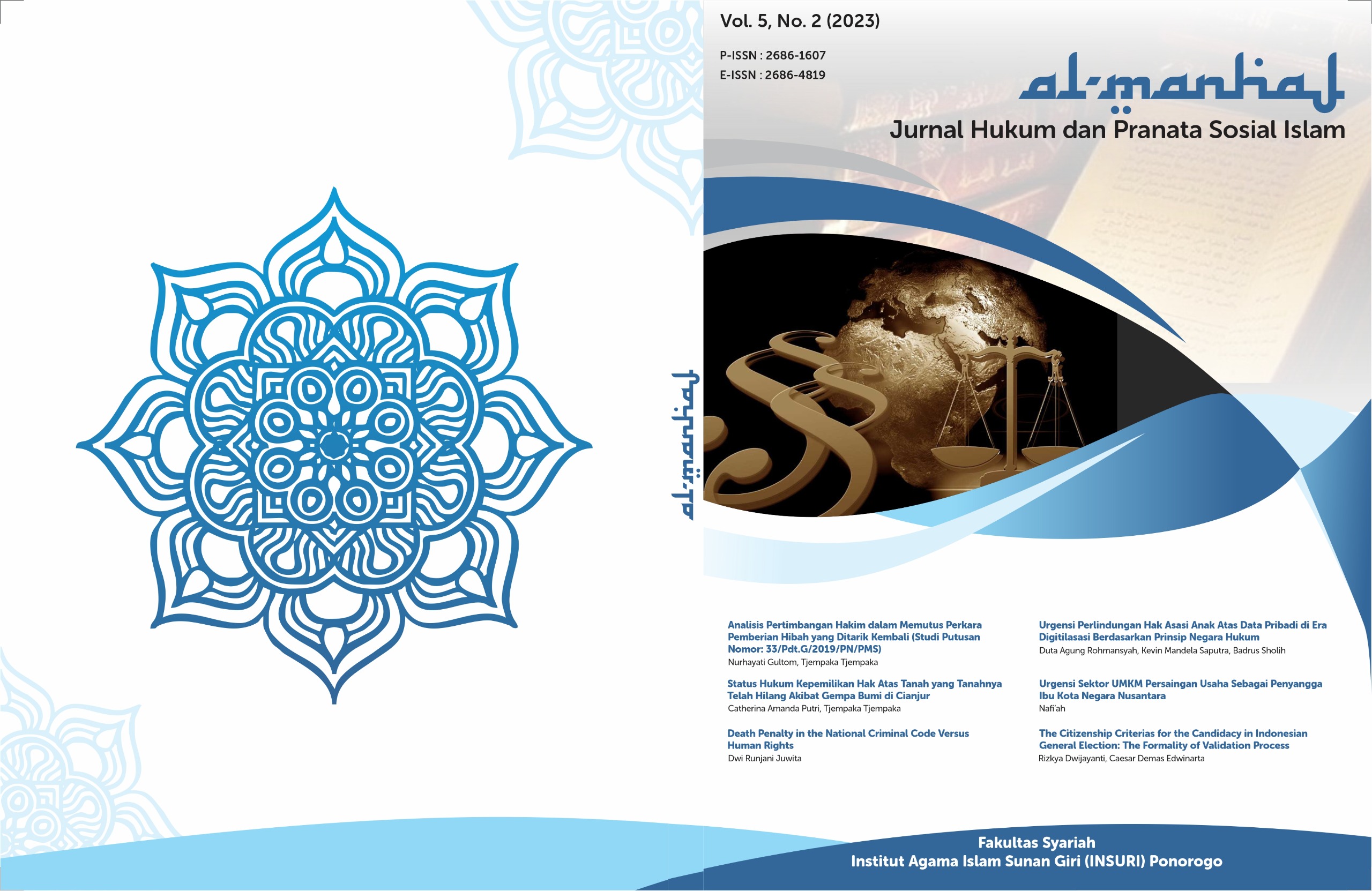Hak-Hak Penyandang Disabilitas dalam Proses Penyebarluasan dan Partisipasi Masyarakat dalam Pembentukan Undang-Undang Nomor 11 Tahun 2020 Tentang Cipta Kerja
DOI:
https://doi.org/10.37680/almanhaj.v5i2.3957Keywords:
CPRD; Job Creation Law; Person with DisabilitiesAbstract
The dissemination and public participation process should be evenly distributed to every community group, including groups of Persons with Disabilities. It is because groups or organizations of persons with disabilities have never been considered and involved by the Government and the House of Representatives since the beginning of the draft of the Law of the Republic of Indonesia No. 11 of 2020 on Job Creation (Job Creation Law) discussion. The substance of the law is very relevant and will impact persons with disabilities. The non-participatory process of drafting the Job Creation Law stems from a non-transparent process characterized by the difficulty for the public to access documents related to the discussion of the law. The lack of public involvement, mainly of persons with disabilities, has also been the criticism target in forming this law. This research method is doctrinal. The results show that the rights of persons with disabilities in the process of dissemination and public participation have been regulated in the CRPD, this is also related to Meaningful participation, which should have been given by the government and the state to all people equally so that their aspirations can be expressed, but the fact does not reflect this, as the Job Creation Law which seems hasty and lack of public participation. Therefore, understanding the meaning of principles and implementing the applicable legal norms is needed to realize meaningful participation.
References
Undang-Undang tentang Pembentukan Peraturan Perundang-Undangan, UU Nomor 12 Tahun 2011. LN Tahun 2011 No. 82 TLN 5234.
Undang-Undang tentang Perubahan Kedua Atas Undang-Undang Pembentukan Peraturan Perundang-Undangan Nomor 12 Tahun 2011. UU Nomor 13 Tahun 2022. LN Tahun 2022 No. 143, TLN 6801.
Undang-Undang tentang Penyandang Disabilitas, UU Nomor 8 Tahun 2016. LN Tahun 2016 No. 69 TLN 5871.
Undang-Undang tentang Pengesahan Convention on the Rights of Persons with Disabilities (Konvensi Mengenai Hak-hak Penyandang Disabilitas), UU Nomor 19 Tahun 2011. LN Tahun 2011 No. 107 TLN 5251.
Undang-Undang tentang Cipta Kerja, UU Nomor 11 Tahun 2020. LN Tahun 2020 No. 245 TLN 6573.
Byrnes, Andrew. (2007), From exclusion to equality : realizing the rights of persons with disabilities : handbook for parliamentarians on the Convention on the Rights of Persons with Disabilities and its Optional Protocol, (United Nations: Geneve).
Indrati, Maria Farida. (2021), “Kumpulan Tulisan A.Hamid S. Attamimi: Gesetzgebungswissenschaft Sebagai Salah Satu Upaya Menanggulangi Hutan Belantara Peraturan Perundang-Undangan dihimpun oleh Maria Farida Indrati, (Depok: Badan Penerbit FH UI).
Kelsen, Hans. (2008), Teori Hukum Murni: Dasar-Dasar Ilmu Hukum Normatif, (Bandung: Nusa Media).
M. Friedman, Lawrence. (1975), The Legal System, Asocial Secience Perspective, (New York: Russel Sage Foundation).
Nusryamsi, Fajri. (2015), Et al. Kerangka Hukum Disabilitas di Indonesia: Menuju Indonesia Ramah Disabilitas, (Jakarta: Pusat Studi Hukum dan Kebijakan Indonesia).
Redi, Ahmad & Ibnu Sina Chandranegara. (2021), Omnibus Law: diskursus pengadopasian ke dalam sistem perundang-undangan nasional, (Depok: Rajawali Pers).
Soekanto, Soejono. (2004), Faktor-Faktor yang Mempengaruhi Penegakan Hukum, (Jakarta: PT Raja Grafindo Persada).
Jultje Saiya, Aprilia. et al (2021) “Partisipasi Masyarakat dalam Pembentukan Undang-Undang Cipta Kerja, TATOHI Jurnal Ilmu Hukum, Vol. 1, No. 6.
K. Harjonoa, Dhaniswara. (2020), Konsep Omnibus Law Ditinjau dari Undang-Undang No. 12 Tahun 2011 tentang Pembentukan Peraturan Perundang-Undangan, Jurnal Hukum, Vol. 6 No. 2.
Marzuki, Munawar. bnu Affan, (2021), Analisis dalam Proses Pembentukan Undang-Undang Cipta Kerja Perspektif Undang-Undang Nomor 12 Tahun 2011 tentang Pembentukan Peraturan Perundang-Undangan, Jurnal ilmiah Metadata, Vol. 3, No. 2.
Ramos Pozón, Sergio. (2016), The convention on the rights of persons with disabilities and mental health law: A critical review, Alter, Vol. 10, No. 4.
Ridlwan, Zulkarnain. (2013),Perlindungan Hak-Hak Konstitusional Penyandang Disabilitas (Rights Of Persons With Disabilities), Fiat Justisia Jurnal Ilmu Hukum, Vol. 7 No. 2.
Susilowati, Eny. (2017), Tingkat Keikutsertaan Masyarakat dalam Proses Pembentukan Undang-Undang, MORALITY: Jurnal Ilmu Hukum, Vol. 3, No. 2.
Trimaya, Arista. (2016), Upaya Mewujudkan Penghormatan, Perlindungan dan Pemenuhan Hak Penyandanga Disabilitas Melalui Undang-Undang Nomor 8 Tahun 2016 tentang Penyandang Disabilitas (Ways To Respect, Protect, and Fulfill The Rights of Persons With Disabilities Through Law Number 8 Of 2016 On Persons With Disabilities), Jurnal Legislasi Indonesia, Vol. 13, No. 04.
Zulfatur Amalia, Sundari. (2020), Pembentukan Undang-Undang Cipta Kerja dalam Perspektif Demokrasi, Jurnal Rechten: Riset Hukum dan Hak Asasi Manusia, Vol. 2, No. 3.
Kurniadi, (2020), Catatan Kritis Terhadap Omnibus law RUU Cipta Kerja, diakses pada: https://untan.ac.id/catatan-kritis-terhadap-omnibus-law-ruu-cipta-kerja/
Mahkamah Konstitusi Republik Indonesia, UU Cipta Kerja Dinilai Hilangkan Hak Penyandang Disabilitas, Lembaga Negara Pengawal Konstitusi, diakses pada: https://www.mkri.id/index.php?page=web.Berita&id=17240
Nilawati P, Cheta. (2022). Ketua PBNU Imam Aziz: UU Cipta Kerja Mencacatkan Penyandang Disabilitas, diakses pada: https://difabel.tempo.co/read/1400814/ketua-pbnu-imam-aziz-uu-cipta-kerja-mencacatkan-penyandang-disabilitas/full&view=ok
Novia Heriani, Fitri. (2020), Akui Minim Sosialisasi, Pemerintah Minta Partisipasi Publik Susun Aturan Turunan UU Cipta Kerja, diakses pada: https://www.hukumonline.com/berita/a/akui-minim-sosialisasi--pemerintah-minta-partisipasi-publik-susun-aturan-turunan-uu-cipta-kerja-lt5fa4ad4ec1b24/
R. Arnstein, Sherry. (1969), a Ladder of Citizen Participation, diakses pada: https://www.miguelangelmartinez.net/IMG/pdf/1969_Arnstein_participation_ladder_AJP.pdfm
Shidarta. (2023). Metode “Omnibus Law” dengan Keterlibatan dan Partisipasi Masyarakat, diakses pada: https://business-law.binus.ac.id/2023/02/09/metode-omnibus-law-dengan-keterlibatan-dan-partisipasi-masyarakat/
Downloads
Published
How to Cite
Issue
Section
License
Copyright:
- Author retains the copyright and grants the journal the right of first publication of the work simultaneously licensed under a Creative Commons Attribution 4.0 International License that allows others to share the work with an acknowledgment of the work's authorship and initial publication in this journal.
- Author is able to enter into separate, additional contractual arrangements for the non-exclusive distribution of the journal's published version of the work (e.g., post it to an institutional repository or publish it in a book) with the acknowledgment of its initial publication in this journal.
- Author is permitted and encouraged to post his/her work online (e.g., in institutional repositories or on their website) prior to and during the submission process, as it can lead to productive exchanges, as well as earlier and greater citation of the published work (See The Effect of Open Access).
License:
-
Attribution — You must give appropriate credit, provide a link to the license, and indicate if changes were made. You may do so in any reasonable manner, but not in any way that suggests the licensor endorses you or your use.
-
No additional restrictions — You may not apply legal terms or technological measures that legally restrict others from doing anything the license permits.
You are free to:
- Share — copy and redistribute the material in any medium or format
- Adapt — remix, transform, and build upon the material for any purpose, even commercially.

This work is licensed under a Creative Commons Attribution 4.0 International License.














